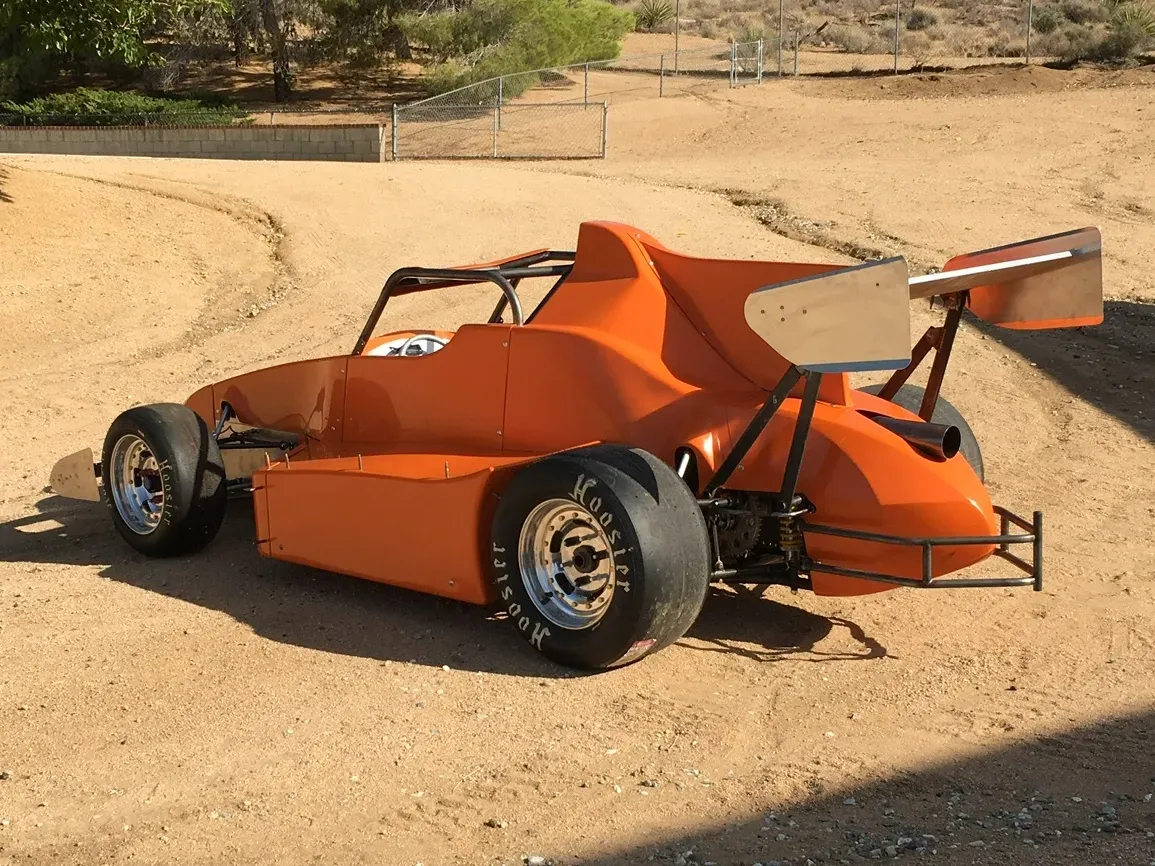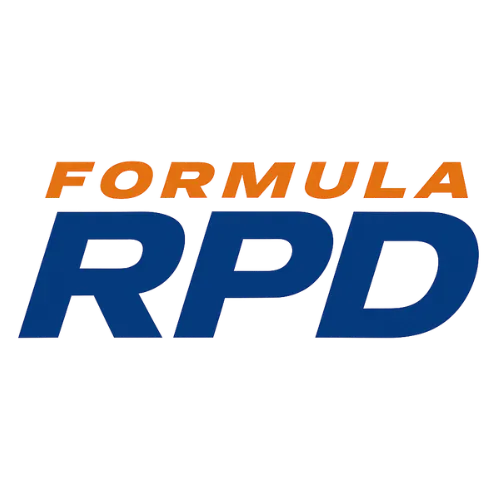Rules
These racing rules are still tentative but are unlikely to change significantly. They deal primarily with the car itself. Other rules covering race procedures, points, purses, and membership will be addressed later.
This class is based on a "spec" car—a single design built by one manufacturer (Note i). The general rule is that the car cannot be modified; however, any adjustment within the provided adjustability is permissible. There are a few explicit exceptions, such as maximum overall width and minimum weight with the driver.

Formula RPD Specifications and Rules
Specifications:
Formula RPD Specifications
Wheelbase (Note ii) ……………………………………………..80 in. to 83 in.
Overall Width (Note ii)……………….…………………………………………. 65 in.
Weight (less fuel) ……….………………………………………..approx. 950 lbs.
Overall Length…………………………………………………………...approx.144 in.
Overall height …………………………………………………………………approx. 45”
Things you CAN do
- use any shock (within a few limits) (Note iii)
- use any type or brand of spring, any spring rate, any type of helper spring or bump stop
- use any type or size anti-roll bar or means of adjustment use any ride height or wheel alignment setting (i.e., toe-in, toe-out, camber, caster, etc.)
- use droop limits
- raise or lower roll centers or use anti-dive or anti-squat geometry (within adjustability provided)
- use any weight distribution scheme (i.e., you can set weight “cross” or add ballast weight to change weight distribution)
- use any wing setting within adjustability range
- adjust tire pressures, modify tires by grooving, siping, shaving, etc.; use tire “stagger” (provided you achieve the stagger with specified tires)
- use tire pressure bleeders
-adjust brake balance (with standard brake bias adjusters or brake bias valves, or by changing master cylinder sizes)
- shut off one or both front brakes on dirt tracks
- use any brake pad compound
- change steering ratio (using pinions provided with the car)use any gear ratio (i.e., you can change both front and rear sprockets)
- Install mechanical in-car adjusters for any chassis function (i.e., brake bias, shock, anti-roll bar, cross weight, wing, etc.) Electric powered adjustments are permitted, but electronically controlled adjustments are prohibited (Note iv)
- convert to a paddle shifter system (Note iv)
Things you CANNOT do
- You cannot change wheel sizes or offsetsYou cannot exceed the maximum overall width (65”)
- You cannot increase or decrease the wheelbase (Note ii)
- You cannot use carbon fiber, titanium, magnesium, or any space-age material to reduce the basic weight of the car (the specifics and exceptions are detailed in section #7)
- You cannot modify the differential (Note v)
- You cannot modify the wings, add aerodynamic features, or modify the body or the underside of the car to gain aerodynamic advantage
- You cannot use anything other than the designated tires, and you cannot chemically alter the tires
Engines
The only engine specified for this class is the Kawasaki ZX14. The early ZX14 was 1352cc. displacement. Engines made after 2011 have a displacement of 1441 cc. (Cars using a pre-2012 engine will be allowed a weight advantage (see section #7 below).
The basic engine rule (Note vi) is that the engine (including the transmission) must remain completely stock, with the following exceptions:
- You can modify the cylinder head and anything that attaches to it (and no, that doesn’t include all the rest of the engine!) any way you want. That means you can change cams, valves, valve springs, ports, combustion chamber, etc.
- You can use any exhaust system design, any air intake system (i.e., air cleaner, air horns, etc.), and you can modify or replace the throttle bodies and/or fuel injectors. The only requirement is that you must use (i.e., start with) the stock head casting.
- You can modify the oil pan and pick-up any way you want. You can add a windage tray.
- You can use an aftermarket clutch
Electronics
- The car is supplied with an ECU made for Formula RPD by Performance Electronics, Ltd. The ECU can be accessed by an app that can be downloaded from Performance Electronics’ website. You can change anything except the max RPM.
- Engine RPM must be limited to a maximum 11,500 RPM.
- Data acquisition is allowed, so long as it doesn’t perform any active engine or chassis functions.
- Any form of electronic traction control or anti-lock braking is forbidden. (Note vii)
Radio Connections and Rear-View Mirrors:
- Two-way radio connections are allowed on road courses and on paved ovals.
- Two-way radio connections are not allowed on dirt tracks.
- One-way radio connections where officials can talk to drivers, but drivers cannot talk to officials, are always allowed wherever the racetrack mandates that requirement.
- Rear-view mirrors are mandatory on road courses.
- Rear-view mirrors are optional on paved ovals.
- Rear-view mirrors are not allowed on dirt tracks.
Fuel
- The only fuel allowed for this class is gasoline. (Note viii)
- Nitromethane, nitrous oxide, methanol, ethanol, or other power enhancing fuels and/or additives are not allowed.
Minimum Weight and Ballast Placement Requirements:
Minimum weight for car, less fuel and driver………….………………….940 lbs.
Minimum weight for car withdriver, but less fuel:
With 1441 c.c. engine (2012 or later) …………………...…………………….….….1125 lbs.
With 1352 c.c. engine (pre-2012).……………………………………………..….…….1050 lbs.
- Where it is necessary to add ballast weight to comply with minimum weight rules, the needed weight must be added in equal amounts to each side of the car on top of the radiator ducts.
- Heavy-duty ducts can be provided where it is necessary to add more than 15 lbs. per side. The heavy-duty ducts themselves add 6 lbs. per side.
- All ballast weights must be marked to show their weight and must be securely attached but easily removable (incase tech inspector wants to verify the weight).
- You can add weight to change the balance of the car if you think it will be advantageous. However, you are not allowed to replicate original components, using lighter materials such titanium, magnesium, carbon fiber, etc., and then add weight where it could be advantageous (e.g., adding lead under the seat) to bring the car back up to the 940 lb. minimum.
- If after a race a car-with-driver is under weight, coolant may be topped up, but if that is not enough to bring the weight up to the minimum, the car is illegal, and subject to disqualification.
Brakes
- Aftermarket brakes may be substituted for the brakes supplied with the car, but the rotors must be cast iron or steel. (Note ix)
- Front and rear brakes must have separate master cylinders, so a loss of pressure in one doesn’t result in total loss of brakes.
- All four wheels must have brakes, but one or both fronts may be shut off for dirt tracks.
- Brake proportioning valves are allowed.
- Driver accessible brake bias adjusters are allowed.
- Any brake pad compound may be used
Wings
- The wings are “spec”. You are not allowed to modify or relocate the actual wing in any way. Only the wings supplied with the car may be used. You are not allowed to add wings.
- You may modify the side plates (spill plates) but you can’t exceed 4 sq ft total area on any one side plate.
- You can adjust the angle of attack within the adjustable range.
Tires
Tires are a strictly “spec” item. Before the first race we will designate exactly what tires are legal for this class. We reserve the right to impose a rule limiting how many new tires a car may use per race. We don’t know yet whether we will do that, but that’s a possibility. We want to keep it simple and easy to enforce, but we don’t want to allow this class to turn into a money spending contest.
You are not allowed to chemically alter the tires (i.e., use tire softening chemicals).
You may modify dirt tires by grooving, siping, shaving, etc.
Safety
- Seat belts must meet SFI 16.5 or SFI 16.1, be within manufacturer expiration label (must have label). Seat belts must be installed and used in accordance with manufacturer’s instructions.
- All participating drivers must wear safety helmets that meet or exceeds the SA 2005 or SA 2010 Snell Foundation or SFI Foundation 31.1 Specifications and are labeled as such.
-All drivers must wear fire resistant underwear, socks, shoes, gloves, and a one-piece uniform fitted snugly around the neck, wrists, and ankles. It is recommended that you also wear a fire-resistant head sock and/or helmet skirt. It is also recommended that all above items meet SFI Foundation Specifications 3.2A and 3.3
- An SFI approved head and neck restraint system is highly recommended. An onboard fire system is highly recommended.
- Removable steering wheel incorporating a quick release mechanism conforming to SFI Specification 42.1 is mandatory.
- All cars must have high impact energy absorbing foam at least 1 in. thick behind, and alongside, of the driver’s head. It is recommended that padding alongside the driver’s head be of progressive density (hardness) to minimize the possibility of low-grade concussions due to the driver’s head continuously hitting the foam, particularly on rough dirt tracks.
- Padding on the roll cage bars is highly recommended. Roll Cage Padding conforming to SFI specification 45.1 is highly recommended.
Driver Eligibility
Formula RPD will issue a license to compete in Formula RPD events to any driver who, in the unanimous opinion of the designated officials, is competent to race in this racing class, and meets any other legal or insurance requirements. However, it should be noted that a unanimous opinion of the designated officials can deny a license, or revoke a license, whenever it is deemed to be in the best interests of Formula RPD and its members.
Certain conditions and exceptions may apply. (Note x)
Notes

Note I
The car is currently being built by Walt Boyd Racing. However, we will likely soon incorporate under a new name—such as Formula RPD, Inc. or Formula RPD, LLC. For now, we will refer to the manufacturer simply as Formula RPD.
For the first racing season, the only available car will be the one built by Formula RPD. We anticipate that other builders may eventually want to construct cars for this class. As Formula RPD owns all rights to the class, it holds the authority to set the terms for licensing other manufacturers.
Our intention is to compile detailed design dimensions and specifications. This will allow other builders to compete based on factors like price, safety, and maintenance costs, while ensuring no significant performance differences on the track. Whether this goal is fully achievable remains to be seen.
Note II
The Formula RPD car was designed with a nominal 81-inch wheelbase. However, the rear suspension arms can be flipped, moving the rear wheels back one inch to create a nominal 82-inch wheelbase. While we have not yet tested the 82-inch configuration, it is an available adjustment and is therefore legal. This may prove advantageous under certain conditions. A tolerance of one inch in either direction beyond the full nominal range is permitted, making any wheelbase from 80 to 83 inches legal.
The car must roll freely through a 66-inch-wide frame. This provides about one inch of tolerance beyond a standard setup. Tires may rub lightly, but the car cannot be forced through, nor is it legal for the crew to lift the car to make the wheels droop for clearance.
Officials may waive the maximum width limit during a post-race inspection if apparent damage from an on-track incident is found.
Note III
Any conventional shock absorber (“shock”, damper) may be used, but
- Maximum of 4 shocks.
- Shocks must be independent from each other with no interconnectivity.
- Shocks must be either non-adjustable or manually adjustable (no electronic controls).
- G valves, inerters, and mass dampers are prohibited.
Note IV
Certain adjustments, such as those for an anti-roll bar, may require an electric motor controlled by driver-accessible switches to be usable during a race. This is acceptable. What is not permitted are any computer-controlled adjustments or systems that could be wirelessly controlled from the pits.
We plan to develop and offer our own in-car adjusters as accessories, including a paddle shifter system. While you are free to develop these components yourself, you must be willing to sell them to us or other Formula RPD competitors at a reasonable price, or allow us to copy them if you hold a patent. We reserve the right to disallow any device that confers a significant performance advantage at an exorbitant cost.
Note V
The Automatic Torque Biasing (ATB) differential represents the best overall compromise for the three different track types this class is designed for. While a different differential or a locked spool might be superior for any single track type, switching between them would require significant work. Furthermore, using a locked rear end on ovals would necessitate rear tire "stagger," which typically increases costs.
The car is supplied with a Quaife ATB chain-drive differential, which is well-suited for this application. This differential cannot be modified; specifically, it cannot be locked. It must retain the behavior of a standard "open" differential when the rear wheels are jacked off the ground.
Note VI
The rationale behind this rule is keeping engine costs to a minimum by allowing only modifications that will (1) increase engine reliability and longevity, or (2) would be too difficult to enforce if forbidden.
In keeping with the basic rule, obviously you can’t increase the displacement. We have a simple way to detect a violation.
Note VII
Electronic traction control is detrimental to the sport; attempt to use it will, if detected, result in the car owner being suspended for at least a year.
Wiring harnesses can be zip-tied to the frame or other components but must not be taped to the frame or other components in such a way as to allow wires to be hidden (i.e., disappearing into frame tubes, etc.).
If traction control is suspected, the tech officials reserve the right to require the car owner to substitute an ECU supplied by the sanctioning body for the day’s activities.
Formula RPD, Inc. will endeavor to keep abreast of all techniques to detect traction control.
Note VIII
Gasoline is the only permitted fuel. While standard pump gasoline is adequate for the stock compression ratio, the rules allow for modifications that may raise the compression to a level requiring race gas. Therefore, the use of race gas is permitted. It may become necessary in the future to specify which brands or types of racing gasoline are legal.
Note IX
The allowance for alternate aftermarket brakes is to enable car owners to potentially secure sponsorship by using a brand other than the standard Wilwood components supplied with the car. We support this opportunity.
However, any alternate brake calipers and/or rotors—including other Wilwood components not originally supplied—must be submitted for approval. The use of rotor materials other than iron or steel, such as aluminum, titanium, ceramic, or carbon, will not be permitted.
Note X
We have not yet drafted a formal "Release of Liability" document. However, all owners and drivers will be required to sign an agreement holding Formula RPD, its employees, members, and all associated parties harmless for any injury or loss resulting from any practice or racing incident involving a Formula RPD vehicle.
At this point, the minimum age requirements have not been finalized. We recognize that some very young drivers are highly skilled and experienced. We are currently reviewing this issue.

